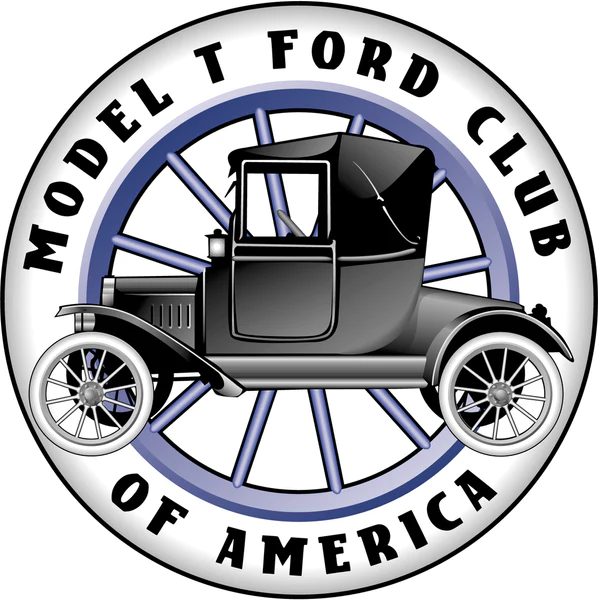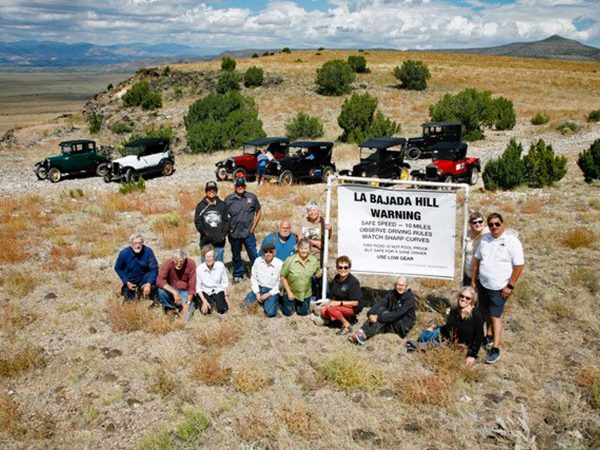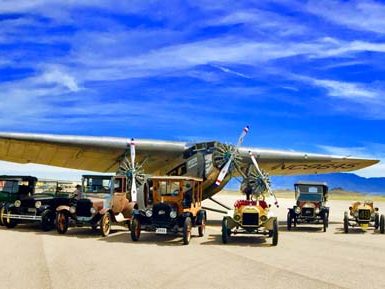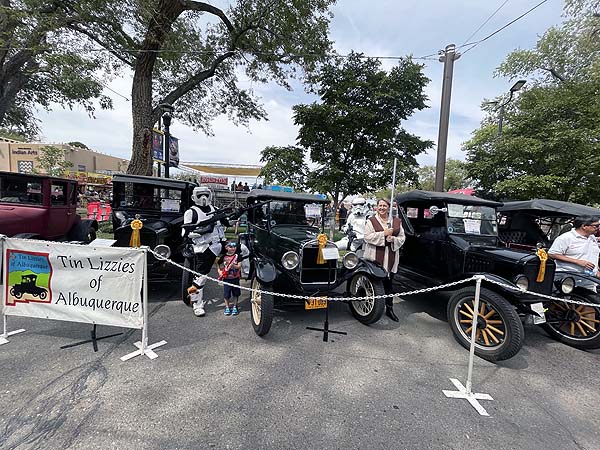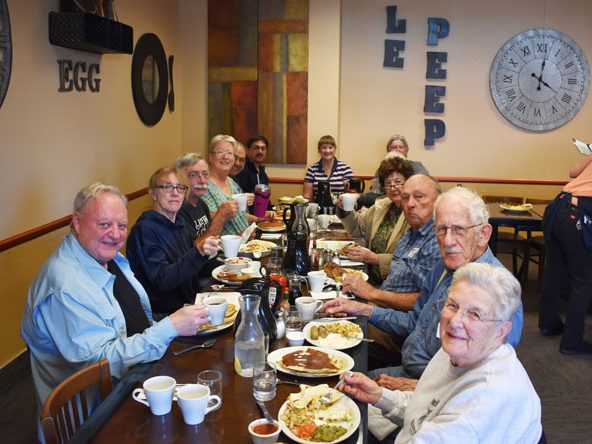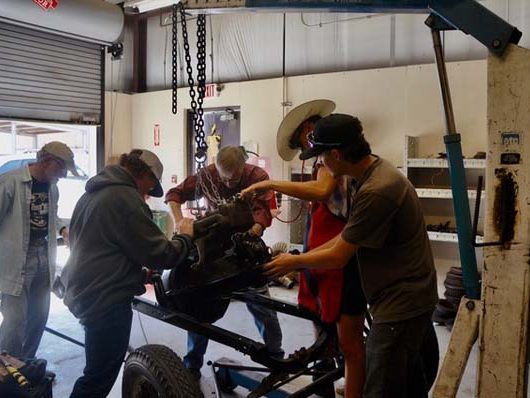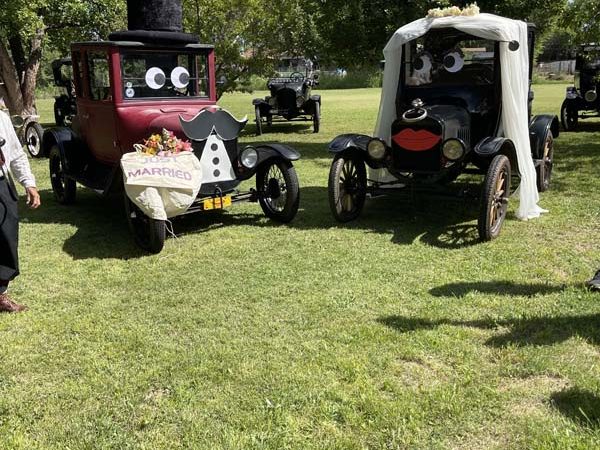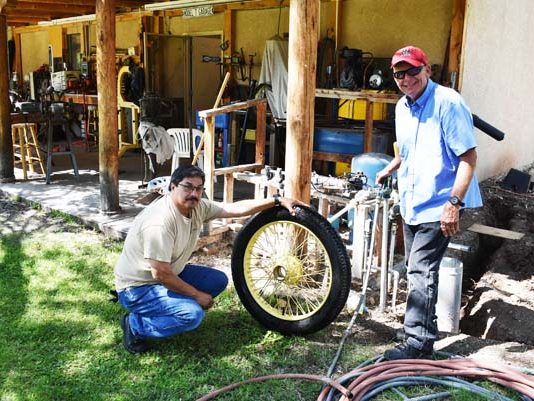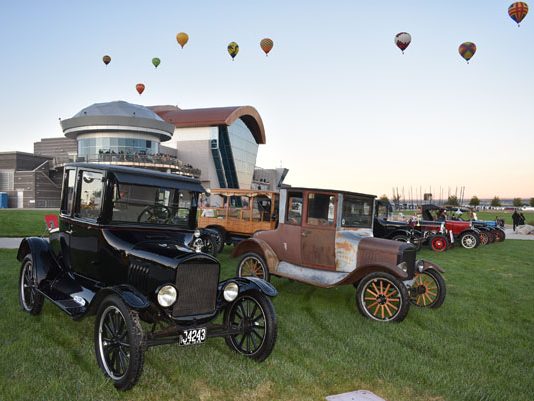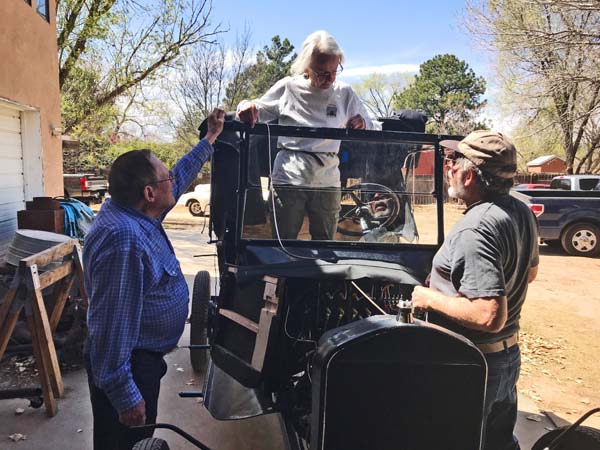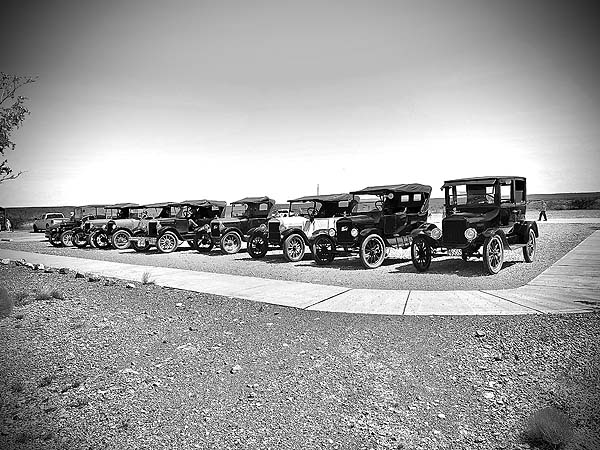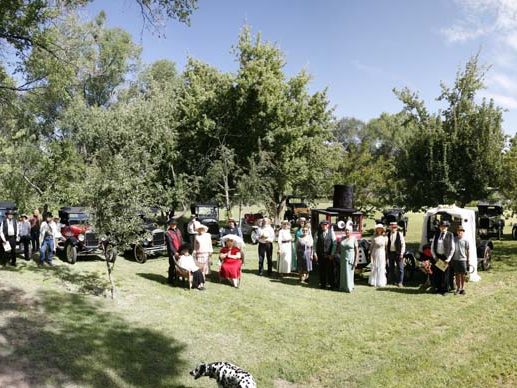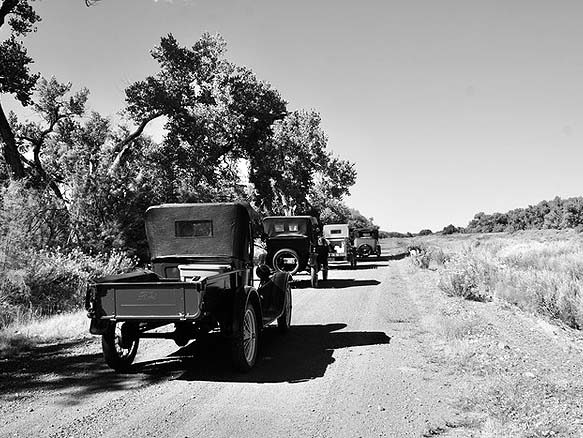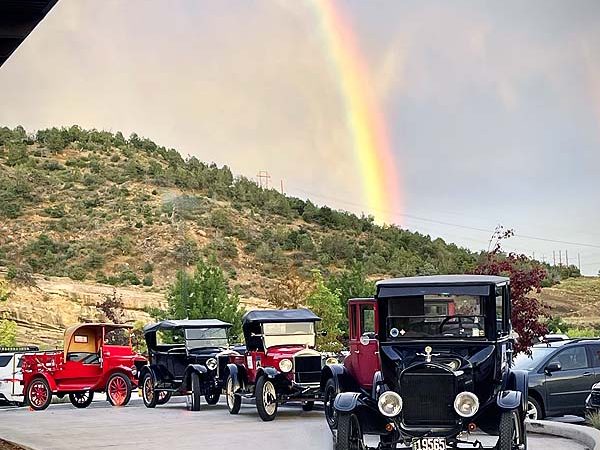Story by Larry Azevedo
One Driver’s Experience in the 2025 Montana 500 Endurance Run
Friday, 6/13
Dave Ferro and Larry Azevedo left Albuquerque at 4:30 AM on Friday, June 13. Kirk Peterson (Santa Fe, NM) met us in Cuba (New Mexico!) on the way to Farmington, NM. We worked our way up through SW Colorado, up SE Utah finally reaching Layton (north of Salt Lake City) at 5:30 PM. We continued on Saturday morning finally arriving at the Helena Inn at 5 PM. We spent the rest of the afternoon with dinner and reconnecting with fellow drivers from Kansas, California, Montana, and Illinois.
Sunday, 6/15
Everyone was out ‘tuning’ their cars this morning. Tire pressure checks, spark plug inspections, checking timers, oil, water, etc. were the activities in the morning. Inspections started at noon and a head count found 16 cars ready to be inspected. Rick Bonebright had brought to t-shirt, hat and jacket orders from Missoula along with his 27 Coupe but he did not compete this year and had to go back home in the evening. We assigned a couple of volunteers to confirm working headlights, tail lights, stop lights and horn which led to some frantic repair activities for a few cars. Rick Bonebright was assigned to inspect timers and then seal the timer wiring and intake manifold with a special unique sealing paint color. (Timers can still be removed for servicing during the competition and can be replaced if needed.)
Another group installed sealing wires on head bolts, carburetor bolts and pan inspection bolts. Each windshield was sealed shut with wood slats and sealing wires. Each driver is responsible to visually inspect the integrity of each seal and report to competition officials is a seal is disturbed. Finally, the two cars that had Rocky Mountain brakes were inspected to ensure that the transmission brake was operational and in working order and the transmission cover was sealed (again ,the driver can remove the transmission cover for band adjustment if needed during the competition and then get the cover resealed). Last fall the Association members voted to allow vintage style (no hydraulics, etc.) Rocky Mountain brakes on cars.
Finally, the 7 Directors in attendance (Meghan Teats, Rick Bonebright, Tony Cerovski, Janet Cerovski, Kirk Peterson, Sonny Bishop and Larry Azevedo) as a group inspected each of the 16 cars and made decisions concerning the legality of body parts, fenders, hoods, radiator, suspension, any potential aerodynamic modifications, top, etc. For example, was it OK to remove saddles on top bow struts if the top is up? The reason for this was to eliminate any legality questions for the winning car during the Wednesday tear down on some things that could have been fixed before the competition. All cars were now ready for competition and the driver’s could fill their gas tanks (during inspection tanks must be ½ full or less).
We had our Sunday evening meeting with the drivers, timers, radar gun operators and trouble truck drivers. During the meeting safety issues were discussed, drivers were reminded that drafted was not allowed and drivers must follow all rules of the road, drivers were told that we could have radar readings anywhere including driving through construction zones and small towns. Trouble truck phone numbers were distributed. The lead timers (Heather and Meghan) went through the starting process in detail.
Monday routes were initially set up for two legs; the first leg of 126 miles and the second leg of 82 miles. There was some concern that a distance of 126 miles would consume as much as 7 gallons of fuel. The drivers of the pre-26 cars were concerned that the low fuel level near the end of the run would impact performance. After discussion a near unanimous vote resulted in splitting Monday into 3 legs of 88, 39 and 84 miles.
Our starting timers were Meghan Teats and Heather Robinson, arriving timers were Sharon Pester and Kathy Wright, computer data entry was handled by Brian Ching, and trouble truck drivers were Sonny Bishop, Ed Delach, Paul Shindlebeck, Paul Christofferson and Jake Beverage.
Finally, starting numbers were randomly drawn for the Monday morning start. The starting order was the following:
- Eddie Wright (26-7 Roadster pickup)
- Doug Monger (Touring)
- Janet Cerovski (26-7 Roadster)
- Conrad Wendland (Roadster)
- Kirk Peterson (24 Coupe)
- Jerome Pester (Roadster)
- Mike Wendland (Roadster)
- Ivan and Wayne Yurtin (26-7 Touring)
- Bill Comer (26-7 Touring)
- KB Murphy (Coupe)
- Mike Hewitt (26-7 Roadster)
- Dave Ferro (24 Touring)
- Tony Cerovski (26-7 Roadster)
- Larry Azevedo (25 Roadster)
- Harley Leach (Roadster)
- Mike Cuff (Roadster)
Monday, June 16
This morning, I woke up at 6 AM and had a very light breakfast with NO coffee. My bladder can’t handle 60+ miles of a Model T going down the road. Everyone left the hotel about 7:30 AM and toured up I-15 northbound to the starting point at mile marker 200. Our first leg was 88 miles. We started at MM 200 northbound on I-15 and then taking 287 and a left at the intersection of Hwy 200, then SW on 200 and flagging in at Lincoln. On this leg we summited Rogers Pass (5610’). At this first stop everyone filled up with fuel, checked oil and water levels and serviced timers, as needed. At this stop Mike Cuffe came to me and reported that he had accidentally taken Hwy 434 which reduced his mileage by 20 miles. After arriving at the stop and discovering his mistake he did not want to travel back to add the mileage and for the rest of the endurance run his mileage was reduced and his final result would be below the slowest car that finished the full course. My roadster took 6.6 gallons of fuel and had we gone the original distance of 126 miles I might have been running on fumes at the end! (Note: We toured about 8 miles to the starting point, so my car got about (88+8)/6.6 = 14.5 miles per gallon.)
In the second leg we left Lincoln and traveled to Sinclair for 39 miles. I needed 2.8 gallons of fuel. Leg 3 was Hwy 200 to 141 and 12 back to Helena, going over MacDonald Pass (6320’) for 84 miles. At the end of leg 3 I needed 6.6 gallons of fuel (I run regular 87 octane as my engine at high rpm has a tad more power with 87 octane compared to 91 octane.)
By the end of the day 3 cars had a variety of problems which put them on the trouble trailers. At 40 miles Tony had something come loose inside his transmission. With 134 miles completed KB had engine trouble and Bill Comer had engine trouble at 83 miles. We started the endurance run with 5 trouble trucks which were needed!
On Monday night we had our driver’s meeting and discussed the day and radar gun results were reported. No one was penalized, one car came close to a penalty but dodged the bullet.
The standings at the end of day 1 were the following:
- Eddie Wright
- Janet Cerovski (approx. + 10 min)
- Harley Leach (approx. +1 min from Janet)
- Larry Azevedo (approx. +5 min from Harley)
- Mike Hewitt (approx. +5 sec from Larry)
- Conrad Wendland (approx. +1 min from Mike)
- Jerome Pester (approx. 4 min from Conrad)
- Dave Ferro (approx. 10 sec from Jerome)
- Mike Wendland (approx. 4 min from Dave)
- Kirk Peterson (approx. 4 min from Mike)
- Doug Monger (approx. 13 min from Kirk)
- Ivan and Wayne Yurtin
- Mike Cuffe
- KB Murphy
- Bill Comer
- Tony Cerovski
Many thanks to Brian who entered the timing data and did real time map constructions for the drivers!
Tuesday, June 17
Today was another long day including 4 legs totaling 245 miles. All the cars started in reverse order, slowest out first, fastest out last.
On leg 4 we departed from Montana City and Grill traveling south on I-15 towards Butte, I-90 west and flagging in at Rocker. I needed 4.6 gallons of fuel. Leg 5 was Rocker to Dillon where I took 3.9 gallons. This was an interesting leg for me. I passed Kirk and Mike and a little later I see Kirk’s red coupe coming up in my rear view mirror. I thought ‘Kirk is doing great!’. He passes me and I give him a thumbs up. Next in my rear view mirror is Mike, evidently he’s doing great also. I think: ‘either both of them are going great OR maybe it’s me! I fiddled with the coils and timing a little and got the car running better.
Leg 6 was Dillon to Whitehall (3.4 gal) and Leg 7 was from Whitehall to Helena (4.0 gallons). We crossed over Elk Park Pass (6968’) and Homestake Pass (6375’). My T ran better than Monday. On Monday I had troubles with coil contacts and two coils had seriously drifted out of spec when I checked them on Monday evening. Today there was one stop where my oil had dropped down to 1.5 qtrs. which is below my lower limit of 1.75 qtrs. I usually start with about 2.5 qtrs. of oil before a run. I usually consume and/or leak about 1 pint per leg. Fortunately, I did not wipe out any bearings!
At our driver’s meeting on Tuesday night, we reviewed the day and reported radar gun results. No one was penalized.
On Tuesday the results were the following:
- Eddie Wright
- Larry Azevedo (approx. +13 min)
- Harley Leach (approx. +10 from Larry)
- Jerome Pester (approx. +4 min from Harley)
- Janet Cerovski (approx. +3 min from Jerome)
- Mike Wendland (approx. +13 min from Janet)
- Kirk Peterson (approx. +7 min from Mike)
- Ivan and Wayne Yurtin (approx. 1 hr. 40 min behind Kirk)
These were the only cars at this point that had finished the full mileage.
Conrad had a freeze plug failure before the start in the morning.
Dave had ignition problems on Tuesday’s first leg.
Doug had engine troubles.
Mike Cuffe was still running with short mileage.
Wednesday, June 18
Today we only had one leg to finish out the 500 miles. We left from mile marker 187 on I-15 and went north to MM 216, turned around and flagged in at MM 200.
Finally, the final 8 cars in the running ended in the following order.
- Eddie Wright
- Larry Azevedo
- Jerome Pester
- Harley Leach
- Janet Cerovski
- Mike Wendland
- Kirk Peterson
- Ivan and Wayne Yurtin
After flagging in we toured to Tony and Janet’s home where they hosted the teardown inspection in Tony’s shop.
Teardown Inspection of the Lead Car
The inspection team was composed of Larry, Jerome, Harley, Janet and Mike Wendland. The team nominated Larry as the lead. The team followed the written teardown manual.
There were 6 directors present at teardown (Larry, Tony, Janet, Kirk, Meghan and Sonny). The rules require that if any potential issues are identified by the inspection team, then the issue is presented to the directors for a decision. The decision can be pass, a time penalty or disqualification by reference to the rules. In addition, the directors have the option to present the issue to the drivers that are present who can then vote.
Since Larry’s car was in second place so he obviously had a conflict of interest. He therefore recused himself from any director votes.
Level one teardown starts by inspecting items before disassembly. The carburetor, pan, head bolt, windshield and timer seals were inspected and confirmed to be in place. The ignition switch was inspected and careful inspection did not reveal any evidence of auxiliary devices or modifications to the ignition system. The battery voltage was measured at 6.34 volts. The engine was started, and an ac voltmeter measured the idle voltage as about 12 volts rms and high-speed voltage greater than 30 volts rms. The magneto post was disconnected, and an ohmmeter confirmed the absence of any devices such as diodes. The coils vibrated with the ignition switch to BAT. With the engine running the timer was adjusted from full retard to full advance on battery and magneto and the engine response was consistent with an engine running on 6V and magneto voltage.
All the coils were removed and carefully inspected for illegal modifications. All body parts were confirmed to be metal. The pickup box had been inspected before the competition. Gas tank was original under the dash. The fuel line ID was less than 3/8 inch. The carburetor was swayback design. The exhaust pipe was at least 36 inch length of 1.5 inch OD. The rear end ratio was confirmed to be 3.64 by turning the crank with the transmission in high gear and counting the crank turns compared to the rear wheel rotation.
The front and rear spring leaves were confirmed to be at least 7 leaves each. There were no auxiliary pan arms, no steering dampeners and no other visible out of spec parts.
At this point the inspection team presented their results to the directors who accepted the results and then voted to continue the teardown to level two which includes disassembly and examination of parts.
The timer was removed and inspected and was found to meet requirements. Careful inspection of all the wiring found no evidence of illegal devices such as electronic devices. The spray needle was removed and its diameter was measured with a 0.122 inch diameter, within requirements. The fuel was drained from the carb and smelled normal. All the butterflies and shafts were present in the carb. The carb inspection procedure allows the driver to select the first individual to dimensionally inspect the carb. Larry was selected and used the 0.713” gauge and the “W” gauge and concluded that the carb passed the dimensional inspection. No evidence of illegal internal modifications to the carb was found.
The transmission cover was removed and there was no evidence of a shaved flywheel. All the three bands were functional. The outer zerks were removed from the rear axle and the presence of roller bearings was confirmed.
The head was removed and the carbon was cleaned from the combustion chambers. Larry measured #1 cylinder with a volume of 281.8 cc. The other members of the inspection team measured #2, #3 and #4 with volumes of 283.7, 284.9 and 284.8, respectively. The minimum allowed volume is 270 cc.
The cylinder bore was confirmed with the go / no-go gauge. The sweep of the piston was less than 0.400 inch above the head gasket. The intake and exhaust manifolds were removed. The no-go gage did not pass through the intake ports or #1, #2 , #3 exhaust ports. The no-go gage did not pass through any of the gland rings, however it barely passed through #4 exhaust port. Close examination of the port showed no evidence of grinding or polishing. Since the no-go gauge passed through #4 exhaust the observation was presented to the directors for a decision. All the directors closely observed the port and they unanimously voted to not issue any penalties.
The inside of all the ports were felt with fingers and no evidence was found of grinding or modifications. The intake manifold met the dimensional requirements.
The crankcase cover was removed. There was no evidence of an oil dam, the flywheel and magnets met requirements. The rods are allowed Synder rods and are babbitted. There was no evidence of rod modifications. There were no notches in the block in the camshaft bores. The crank is a Model T crank with no modifications. The tappet foot was original. The valve head diameters met requirements.
At this point level two was complete and these results were accepted by the directors. The directors then voted to stop and not proceed to level three which would have removed bearings for dimensional checks.
At this point the directors announced that Eddie Wright was the 2025 Montana 500 winner!
We got Eddie’s car reassembled and confirmed that it still ran! After a great meal of fried chicken and salads at Tony and Janets we had an awards ceremony. Janet was given the Rattle Can award which is awarded to someone who demonstrates the great characteristics of helping others.
Bill Comer and Tony Cerovski were voted to share the Bud Peters award as the most inspirational person contributing to our Endurance Run.
Thanks again to all our volunteers. Without them this event would not be possible. It was a fun event this year and we are all looking forward to next year.
